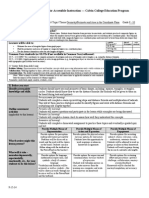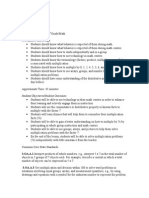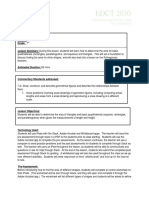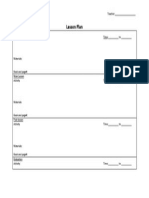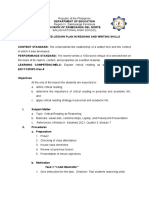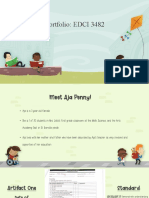Taxi Distance LP
Taxi Distance LP
Uploaded by
api-270322298Copyright:
Available Formats
Taxi Distance LP
Taxi Distance LP
Uploaded by
api-270322298Original Title
Copyright
Available Formats
Share this document
Did you find this document useful?
Is this content inappropriate?
Copyright:
Available Formats
Taxi Distance LP
Taxi Distance LP
Uploaded by
api-270322298Copyright:
Available Formats
Hagel 1
Kayla Hagel
11/20/14
MTH 462
Unit Plan
Lesson Plan #1
7-3 Part A: Taxi Distance
Teacher: Kayla Hagel
Topic: Taxi Distance
Length of Lesson: 50-60 minutes
Goals and Objectives
Mathematical Goals:
o Students will use their previous knowledge about distance on a number line to
find distance on a grid, moving horizontally and vertically.
o Students will understand and properly use the following vocabulary term(s):
Taxi Distance
Mathematical Objectives:
o Students will find the taxi distance of two points in two distinct ways: graphically
and by using the formula.
Previous Knowledge:
Students have prior knowledge of finding distance on a number line.
Students are familiar with coordinate planes and can identify the x-axis and y-axis.
Students know the proper notation for points on a coordinate plane: (x, y)
Materials:
Graph paper one for each student
Pencil (or pen) one for each student
Notebooks or paper for note taking purposes
Textbook pages 496-498
Anticipatory Set: (10-15 minutes)
Students are asked to write the number of the homework problem(s) they had trouble
with from the previous nights assignment on the board as they come into the classroom.
o If there seems to be many homework problems written on the board, the teacher
could choose to abandon the warm-up activity and move right along to homework
review.
o If there are only a few homework problems written on the board, the teacher
should go ahead with the planned warm-up activity. Questions about the
homework assignment will be answered after the warm-up activity.
Before beginning the lesson, students will complete a warm-up activity. This warm-up
activity will require students to use their prior knowledge to complete the exercises.
Hagel 2
Teacher
Decide whether or not to do
the warm-up activity based on
the number of homework
questions students wrote on
the board.
Student
Students should write the
number of the homework
problem(s) on the board as
they enter the room then find
their seats and prepare for
class to start.
Rationale
The teacher can use this as a
formative assessment of
previous lessons. At this point
the teacher can decide whether
or not to do a warm-up
activity or just focus on
homework questions and
move right into the next
lesson.
Gain students attention and
display warm-up exercises on
the board. Ask the students to
begin working on the warm-up
and be prepared to share their
answers in about 5-7 minutes.
Students should begin
working on the warm-up
questions. They are welcome
to work with a partner if
needed.
A warm-up activity is
conducted prior to starting the
lesson because it gets the
students thinking about
mathematics, and it helps the
students recall any prior
knowledge that may be useful
for the upcoming lesson.
Reviewing absolute value will
be useful for todays lesson.
Solve.
1. |
1. 51
2. |
2. 33
3. |
3. 37
4. |
4. 33
5. |
5. 19
Once the teacher sees that
most of the students are
finished with the warm-up, the
teacher should call the
students attention back to the
front of the room and begin
reviewing the answers to the
warm-up questions in a whole
class discussion.
Student should be prepared to
share their answers and
explain their reasoning.
Discussing the answers to the
warm-up is a great way to
clarify questions and
formatively check for
understanding.
After completing the class
discussion on the warm-up
activity, the teacher should
move on to answering
Students should have written
the number of the homework
questions they struggled with
on the board as they entered
Reviewing problems from
previous homework
assignments is a great
opportunity to reteach
Hagel 3
questions about the previous
homework assignment.
the classroom. At this point
they should be ready to
discuss the homework
problems on the board (or any
others they may have had
trouble with).
concepts that may be
confusing to the students. This
time can be used as a
formative assessment of prior
lessons.
Once there are no more
questions about the previous
homework assignment, the
teacher should collect the
students homework.
Students should turn in their
homework assignment.
The students homework
assignments will be graded
and used as a formative
assessment.
Information and Modeling: (15-20 minutes)
This portion of the lesson will use the following images on page 496-497 in the textbook.
Teacher
Student
The teacher should pass out The students should get out
graph paper to each of the their notebooks and open their
students.
books to page 496.
Rationale
The teacher should introduce the Students should take notes These notes will be useful in
topic of taxi distance by about the idea of taxi distance the future for homework and
explaining what it is and and its definition.
studying purposes.
Hagel 4
providing a formal definition.
The idea of taxi distance
comes from the fact that
not all of the paths we
take in life are direct.
Sometimes
our
movements are dictated
by streets or sidewalks.
Taxi distance (or grid
distance) refers to the
shortest or most direct
route between two points.
The teacher should begin todays
lesson on taxi distance by
introducing the All Around the
Town exercise on page 496 in
the textbook.
Instruct the
students to record the image on
their graph paper.
Students should follow along
and record the image on their
graph paper including the
various locations.
After the students have recorded
the image on their graph paper,
the following questions should
be explored independently:
1. How far is it from
Florences
house
to
school? (She must stay
on the horizontal and
vertical streets.)
1. 6 blocks
If the students are not getting
6 blocks, its probably because
they are not taking the shortest
(or most direct) route. Remind
them to do so.
2. How many different
routes can Florence take
to
Larrys
without
backtracking?
2. 6 routes
All six of the routes should be
demonstrated (either by the
teacher or by the students) so
that everyone can see each
route clearly.
3. The map shows the route
Florence took one day,
stopping at Larrys house
on the way to school.
How long is this route?
Is there a shorter route
3. 10 blocks. There is no
shorter route that stays
on the streets.
Have students share
the different routes
they came up with to
Students should be given
enough time to explore many
possible routes before arriving
at this answer. Students should
also begin to see that all of the
routes (with these given
Hagel 5
that connects all three
places? Explain.
prove this answer is conditions) are 10 blocks long.
correct.
4. Using the graph paper,
draw two routes Florence
can use to stop at the post
office on the way to
school.
Record
the
coordinates of the routes.
How long are these
routes?
How long is the shortest
route?
4. The shortest route is 14 This further demonstrates to
blocks.
the students that it doesnt
matter which route you take,
they will all be the same
length (as long as they are the
most direct/shortest routes).
5. Using your previous
answers, describe how to
find the taxi distance
between two points on a
grid.
5. Add the difference in
the x-coordinate and
the difference in the ycoordinate.
Students may not see this
pattern right away. Give them
time to explore this idea with a
partner (or small group) to
arrive at a possible solution.
The teacher should now direct
the students attention to the
three small tables on page 497.
These images depict possible
routes Larry can take to school.
The students should observe
that all of the routes are 6
blocks long regardless of the
path taken.
It should be made clear that
the length of the route remains
constant no matter which route
Larry takes to school. Allow
the students enough time to
fully explore this idea before
moving on.
The teacher should now Students should record this This formula will be used
introduce the formula for taxi formula in their notes.
multiple times the future, so
distance.
the students should have it
accessible to them at all times.
The taxi distance from
to
is
|
| |
|
Checking for Understanding: (5-10 minutes)
Teacher
Student
The teacher should
Students should record these
demonstrate this formula by
example problems in their
asking the students to talk
notebooks.
him/her through a few
example problems.
Rationale
Having the students observe
how to use the taxi distance
formula will help them to
understand how to use it on
their own. Having these
example problems recorded in
their notebooks will give the
Hagel 6
students something to refer
back to if they run into trouble
in the future.
1. Find the taxi distance
between (10, -3) and
(-2, 4).
1. |
|
|
|= 19
2. Find the taxi distance
between (10, 23) and
(9, 28).
2. |
6
3. Find the taxi distance
between the post office
and the school. (See
image on page 496)
3. The post office is
located at (3, 6) and
the school is located at
(9, 2).
|
| |
|= 10
4. Why do we use
absolute value signs in
the taxi distance
formula?
4. Because we are
working with distance.
Distance cannot be
negative so we must
use absolute value
signs to show positive
distances.
Guided Practice: (5-10 minutes)
Teacher
Student
The teacher should assign the Students should work
following questions and check independently or with a
the students responses before partner to complete the
allowing them to begin their
assigned questions.
homework assignment. (This
could be considered a ticketout-the-door.)
Find the taxi distance for the
following points:
1. (4, 4) and (12, 4)
2. (8, -2) and (6, -4)
3. (-4, 3) and (4, -1)
1. 8
2. 4
3. 13
|=
Students should be able to
explain where to plug the
coordinates into the taxi
distance formula and solve for
the taxi distance.
It is good to remind the
students of the concept that
distance cannot be negative
because it is an important
concept when finding taxi
distance.
Rationale
These few questions can be
used as a formative
assessment of todays lesson.
The teacher should check to
see that the students have
these questions correct before
allowing them to start their
homework assignment.
Hagel 7
Formative Assessment:
The teacher should collect each of the students responses to the taxi distance questions
assigned during guided practice section and use these responses as a formative
assessment of the days lesson.
The teacher should have been formatively assessing the students throughout the lesson
(I.e. analyzing their responses to questions asked during the lesson/class discussion)
The students will have the remaining class time to ask questions and begin working on
their homework assignment.
Adaptation, Reteaching, Extension, and/or Independent Practice:
The following exercises should be completed outside of class and returned at the
beginning of the following class period:
o Page 498 #2-5, 9, 10 and 14
The objectives of this lesson will also be revisited and reevaluated during the Final Exam.
You might also like
- Mastering Essential Math Skills, Book 1: Grades 4 and 5, 3rd Edition: 20 minutes a day to successFrom EverandMastering Essential Math Skills, Book 1: Grades 4 and 5, 3rd Edition: 20 minutes a day to successNo ratings yet
- 5e Lesson - Equivalent FractionsDocument7 pages5e Lesson - Equivalent Fractionsapi-272826545100% (4)
- Lesson 4-Thinking Addition To 18 To SubtractDocument3 pagesLesson 4-Thinking Addition To 18 To Subtractapi-273444334No ratings yet
- Reflective Lesson Plan 6 Distance FormulaDocument7 pagesReflective Lesson Plan 6 Distance Formulaapi-339897912100% (1)
- Lesson 1 Composite FiguresDocument3 pagesLesson 1 Composite Figuresapi-283338157No ratings yet
- Mrs Singhs Lesson Plan 3Document3 pagesMrs Singhs Lesson Plan 3api-341871037No ratings yet
- EDUC Lesson PlanDocument7 pagesEDUC Lesson PlanLindsey WhitmoreNo ratings yet
- Lesson PlanDocument5 pagesLesson Planapi-312746437No ratings yet
- Lesson 2 Perimeter and Area in The Coordinate PlaneDocument3 pagesLesson 2 Perimeter and Area in The Coordinate Planeapi-283338157No ratings yet
- Math Unit Plan - PortfolioDocument24 pagesMath Unit Plan - Portfolioapi-543319841No ratings yet
- Activity 5 Math 351Document3 pagesActivity 5 Math 351api-340982837No ratings yet
- LessonDocument3 pagesLessonapi-285080895No ratings yet
- Lesson Plan 3 EditDocument2 pagesLesson Plan 3 Editapi-253999790No ratings yet
- Human Line Plot 1Document5 pagesHuman Line Plot 1api-692127417No ratings yet
- Station Teaching LessonDocument6 pagesStation Teaching Lessonapi-309570912No ratings yet
- Nicomegan OnecomputeroneprojectorDocument3 pagesNicomegan Onecomputeroneprojectorapi-282831628No ratings yet
- Teacher: Miss Cooper Grade: 10-11 Content Area: Honors Physics 1. Content and StandardsDocument3 pagesTeacher: Miss Cooper Grade: 10-11 Content Area: Honors Physics 1. Content and Standardsapi-590983365No ratings yet
- Direct Instruction 1Document6 pagesDirect Instruction 1api-314997078100% (1)
- LessonplanfinalDocument17 pagesLessonplanfinalapi-347695796No ratings yet
- Maths School Map Lesson PlanDocument2 pagesMaths School Map Lesson Planapi-316644222No ratings yet
- Mge MLDP Lesson PlanDocument10 pagesMge MLDP Lesson Planapi-745005042No ratings yet
- Pacheco Signatureassignment Ble407Document24 pagesPacheco Signatureassignment Ble407api-293667101No ratings yet
- Lesson Plan 4Document3 pagesLesson Plan 4api-546537020No ratings yet
- Algebra 2 Lesson Plan 5.4Document3 pagesAlgebra 2 Lesson Plan 5.4houdini4No ratings yet
- Read-Math 9 - Mini Lesson 4 3 Follow UpDocument4 pagesRead-Math 9 - Mini Lesson 4 3 Follow Upapi-349577905No ratings yet
- Shu Lesson Plan 2Document4 pagesShu Lesson Plan 2api-278838777No ratings yet
- Residency Lesson Plan GuideDocument3 pagesResidency Lesson Plan Guideapi-428456935No ratings yet
- Whole Group LessonDocument4 pagesWhole Group Lessonapi-354326721No ratings yet
- Saint Francis University Loretto, PA 15940 Education Department Lesson Plan FormatDocument3 pagesSaint Francis University Loretto, PA 15940 Education Department Lesson Plan FormatArlan ZelenkyNo ratings yet
- BbradshawubdmathlessonDocument4 pagesBbradshawubdmathlessonapi-326630085No ratings yet
- Fe 3 Lessonplanweek 13Document5 pagesFe 3 Lessonplanweek 13api-339865522No ratings yet
- Math Distributive PropertyDocument5 pagesMath Distributive Propertyapi-290457827No ratings yet
- Task 4 ProjectDocument38 pagesTask 4 Projectapi-282105125No ratings yet
- Math Lesson PerimiterDocument6 pagesMath Lesson Perimiterapi-340404014No ratings yet
- Eugenetalbot En453 Ten Day Unit PlanDocument20 pagesEugenetalbot En453 Ten Day Unit Planapi-304800863No ratings yet
- Lesson Plan 9 NewDocument11 pagesLesson Plan 9 Newapi-253005231No ratings yet
- Observation #2 - Math LessonDocument5 pagesObservation #2 - Math LessonAlexandra KeresztesNo ratings yet
- Velezosorio Ob5Document3 pagesVelezosorio Ob5api-407290432No ratings yet
- Schumann Middleton s4 ProposalDocument4 pagesSchumann Middleton s4 Proposalapi-215449942No ratings yet
- Student Teacher: Angela Walter Subject(s) : Math Unit: Unit 5 Lesson Title: Two Step Word Problems in Everyday Life Grade: 3 1. StandardsDocument4 pagesStudent Teacher: Angela Walter Subject(s) : Math Unit: Unit 5 Lesson Title: Two Step Word Problems in Everyday Life Grade: 3 1. Standardsapi-292193880No ratings yet
- TCNJ Lesson Plan: Aim/Focus QuestionDocument8 pagesTCNJ Lesson Plan: Aim/Focus Questionapi-253005231No ratings yet
- Observation 10 29-2Document5 pagesObservation 10 29-2api-235642517No ratings yet
- Lesson PlanDocument3 pagesLesson Planapi-350771839No ratings yet
- LRWMTVPF Lesson Plan 21Document4 pagesLRWMTVPF Lesson Plan 21api-249011209No ratings yet
- Lesson Plan For Elementary Education and Special Education (1-6)Document4 pagesLesson Plan For Elementary Education and Special Education (1-6)api-509081529No ratings yet
- Lesson Planning Form For Accessible Instruction - Calvin College Education ProgramDocument6 pagesLesson Planning Form For Accessible Instruction - Calvin College Education Programapi-336528722No ratings yet
- 8-1 Lesson PlanDocument4 pages8-1 Lesson Planapi-241830835No ratings yet
- Lesson Plan 3-Final-RevisedDocument3 pagesLesson Plan 3-Final-Revisedapi-234882491No ratings yet
- Properties of ParabolasDocument3 pagesProperties of Parabolasapi-352927285No ratings yet
- Math Lesson Plan 1Document2 pagesMath Lesson Plan 1api-267519393100% (1)
- Think Literacy Document: Ideas For Consolidating A LessonDocument2 pagesThink Literacy Document: Ideas For Consolidating A Lessoncathy roseNo ratings yet
- The Following Is A Sample of The Lesson Plan Format Used by The UniversityDocument7 pagesThe Following Is A Sample of The Lesson Plan Format Used by The Universityapi-358178333No ratings yet
- Saint Francis University Loretto, PA 15940 Education Department Lesson Plan FormatDocument3 pagesSaint Francis University Loretto, PA 15940 Education Department Lesson Plan FormatArlan ZelenkyNo ratings yet
- MathunitDocument27 pagesMathunitapi-349893685No ratings yet
- Week2 Day4Document3 pagesWeek2 Day4api-272371264No ratings yet
- Observation #3 - Math LessonDocument6 pagesObservation #3 - Math LessonAlexandra KeresztesNo ratings yet
- Edn Final LessonDocument3 pagesEdn Final Lessonapi-253446923No ratings yet
- Lesson Planning Form For Accessible Instruction - Calvin College Education ProgramDocument4 pagesLesson Planning Form For Accessible Instruction - Calvin College Education Programapi-336528722No ratings yet
- Teacher: Miss Cooper Grade: 10-11 Content Area: Honors Physics 1. Content and StandardsDocument4 pagesTeacher: Miss Cooper Grade: 10-11 Content Area: Honors Physics 1. Content and Standardsapi-590983365No ratings yet
- Informational Text Toolkit: Research-based Strategies for the Common Core StandardsFrom EverandInformational Text Toolkit: Research-based Strategies for the Common Core StandardsNo ratings yet
- Day ThreeDocument6 pagesDay Threeapi-270322298No ratings yet
- Day FourDocument5 pagesDay Fourapi-270322298No ratings yet
- Seven Continents Climate ActivityDocument4 pagesSeven Continents Climate Activityapi-27032229867% (3)
- Self EvaluationDocument1 pageSelf Evaluationapi-270322298No ratings yet
- Random SampleDocument1 pageRandom Sampleapi-270322298No ratings yet
- Distance Formula LPDocument2 pagesDistance Formula LPapi-270322298No ratings yet
- Lesson 1Document4 pagesLesson 1api-270322298No ratings yet
- Dangers of BeautyDocument1 pageDangers of Beautyapi-270322298No ratings yet
- Lesson TemplateDocument1 pageLesson Templateapi-270322298No ratings yet
- Lesson 2Document1 pageLesson 2api-270322298No ratings yet
- Lesson 3Document2 pagesLesson 3api-270322298No ratings yet
- Lesson Plan 2Document9 pagesLesson Plan 2api-270322298No ratings yet
- Chapter 7 TestDocument5 pagesChapter 7 Testapi-270322298No ratings yet
- Pythagorean THM LPDocument6 pagesPythagorean THM LPapi-270322298No ratings yet
- CM and SRDocument3 pagesCM and SRapi-270322298No ratings yet
- MUET Speaking 800Document4 pagesMUET Speaking 800Revathi Maniam100% (4)
- Revision of SyllabusDocument4 pagesRevision of SyllabusHimansu Sekhar SahuNo ratings yet
- CPD M&E FrameworkDocument15 pagesCPD M&E FrameworkVitalise AdongoNo ratings yet
- Ciscm1a 101 3 2023Document13 pagesCiscm1a 101 3 2023lsg100% (1)
- Susun Atur Acara MSSDDocument84 pagesSusun Atur Acara MSSDCr SJ Tang GbkNo ratings yet
- Chapter 4 (Results)Document20 pagesChapter 4 (Results)Ma Lucille Trina Santos86% (7)
- WCC ScheduleDocument2 pagesWCC Scheduleapi-206502854No ratings yet
- Roles of Social Media in Sustaining Lifelong Learning For Efficiency in National DevelopmentDocument5 pagesRoles of Social Media in Sustaining Lifelong Learning For Efficiency in National DevelopmentInternational Journal of Innovative Science and Research TechnologyNo ratings yet
- Trac Nghiem Tieng Anh Thi Vao 10Document17 pagesTrac Nghiem Tieng Anh Thi Vao 10Hiếu Nguyễn MinhNo ratings yet
- Week 7 LP 2 Reading and WritingDocument4 pagesWeek 7 LP 2 Reading and WritingMA. DIOFEL LACAYANo ratings yet
- Quran para 8Document28 pagesQuran para 8Amjad Khan67% (3)
- English 110.01 - First-Year English CompositionDocument6 pagesEnglish 110.01 - First-Year English CompositionclemenjeNo ratings yet
- Pre-Immersion12 - Q 3 - SLM 1Document18 pagesPre-Immersion12 - Q 3 - SLM 1Gissele AbolucionNo ratings yet
- The Current State of LCUP Graduates: A Tracer Study of MABS Graduates From Academic Year 2012-2013 To 2015-2016Document12 pagesThe Current State of LCUP Graduates: A Tracer Study of MABS Graduates From Academic Year 2012-2013 To 2015-2016Coy SegismundoNo ratings yet
- Cissp Information PDFDocument4 pagesCissp Information PDFZaheer BkNo ratings yet
- International CFQDocument7 pagesInternational CFQapi-311036617No ratings yet
- Unit 14Document11 pagesUnit 14English AnnieNo ratings yet
- Pedagogy of Hope Reliving Pedagogy of THDocument2 pagesPedagogy of Hope Reliving Pedagogy of THArkar KyawNo ratings yet
- Assessment Portfolio Edci 3482Document6 pagesAssessment Portfolio Edci 3482api-437180364No ratings yet
- Taoism and Celts HSC Preliminary Stage 6 SyllabusDocument31 pagesTaoism and Celts HSC Preliminary Stage 6 Syllabusapi-332002291100% (1)
- Leading Private University in Delhi NCRDocument6 pagesLeading Private University in Delhi NCRtanu kapoorNo ratings yet
- The Google Effect: Googling, Blogging, Wikis and The Flattening of ExpertiseDocument11 pagesThe Google Effect: Googling, Blogging, Wikis and The Flattening of ExpertiseAnna YakutenokNo ratings yet
- Frances Michelle Mejia: Work ExperienceDocument2 pagesFrances Michelle Mejia: Work Experienceapi-286215386No ratings yet
- Partido State University HistoryDocument3 pagesPartido State University Historyromeroiimario92No ratings yet
- B.tech. 3rd Year (5th Semester) - EEE - Provisional ResultDocument2 pagesB.tech. 3rd Year (5th Semester) - EEE - Provisional ResulthijoNo ratings yet
- Work Immersion For All Strands Weeks 1 16 Mary Grace Talavera and Van Russel RoblesDocument73 pagesWork Immersion For All Strands Weeks 1 16 Mary Grace Talavera and Van Russel RoblesJasmine Diaz100% (1)
- Baby ThesisDocument9 pagesBaby ThesisKervie BalaseNo ratings yet
- Resume Inggris CVDocument31 pagesResume Inggris CVPH Kota Tegal100% (1)
- Government of India Ministry of Railways Railway Recruitment BoardsDocument1 pageGovernment of India Ministry of Railways Railway Recruitment BoardsparthNo ratings yet
- National Safety Conferences Onsafety in Mines-First To EleventhDocument89 pagesNational Safety Conferences Onsafety in Mines-First To EleventhAjeet Kumar100% (1)








